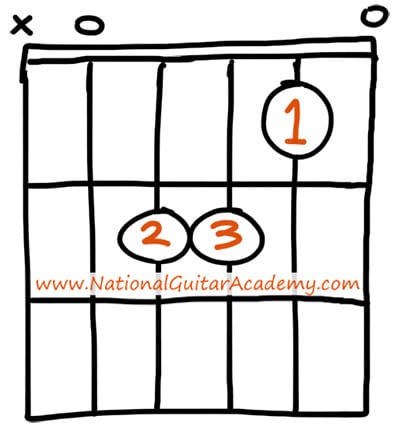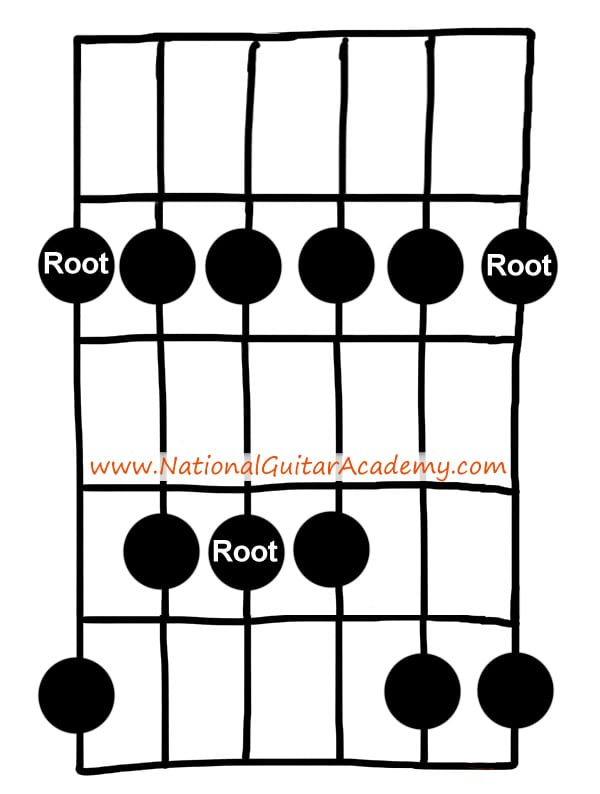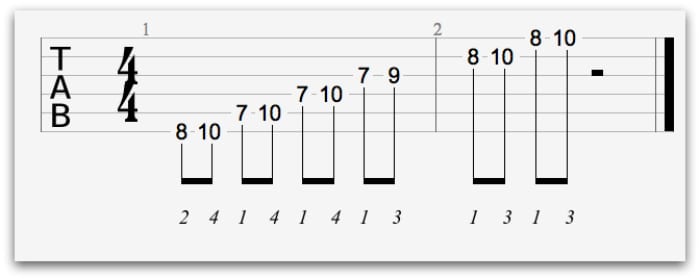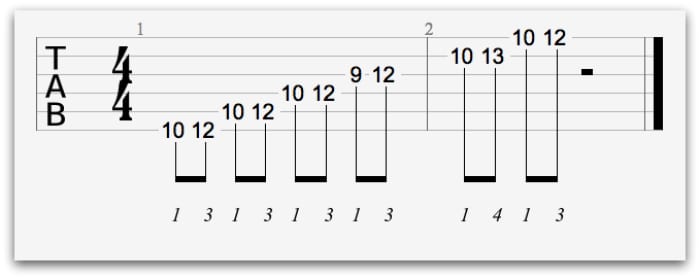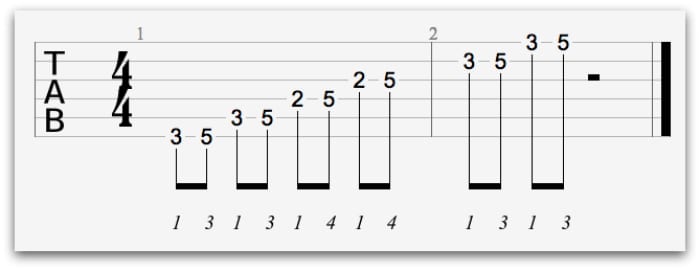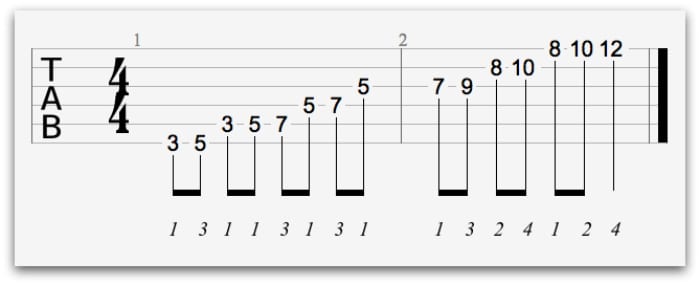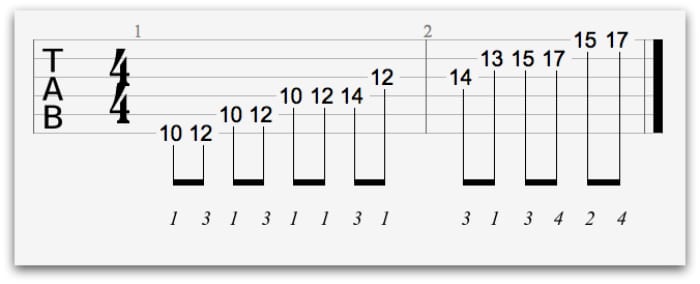What are root notes?
Root notes are the first note in a scale or chord.
For example a A minor chord has the notes A, C and E in it.
But the most important note in this chord is the note A.
- This is the first note in the chord and is therefore the root note.
In your open A minor chord, there is also another root note. This is on the 2nd fret of the G string. (Sometimes you get two root notes in a chord and that’s fine!)
Learn more about root notes here: What Is The Root Note Of A Chord?
Don’t know how to play this chord? Go here: Am Guitar Chord For Beginners
Finding Root Notes In Scales
Root notes can also be found in scales. Luckily for us we can use the exact same rule to find the root notes in a scale.
- To find the root note in a scale, you play the very first note of the scale. That’s your root note.
For example, if you play an A minor pentatonic scale. The notes of the A minor pentatonic scale are A C D E G.
The first note in that scale is the A note. Therefore the A note is the root note.
Just like our chords, we often get more than just one root note in a scale.
You also find root notes on the:
- 7th fret of the D string. (4th string.)
- 5th fret of the high E string. (1st string.)
These are just octaves of our original root note.
To learn more about octaves, go here: Guitar Notes Explained: A Guide For Beginners
(If you don't understand the above image please read our article "How To Read Guitar Chordboxes In 60 Seconds". It will make everything clear!)
Why is this important?
Understanding where the root notes are is vital when learning lead guitar. These are the notes which will make you sound amazing.
When you solo it’s essential that you target the root note when you start and end your phrases. That way your phrases will ALWAYS sound resolved.
Try this as a cool bonus challenge:
- Start your solo using a root note.
- End your solo using a root note.
- Start and end your solo using a root note.
With these essential tips you’ll be rocking in no time.
As well as learning our core pentatonic scale shape, there are some other hidden pentatonic shapes which also sound great. Let’s learn them.
The A Minor Pentatonic Scale – Pattern 2
This is a great pattern to get under your fingers. In this scale you’ll find SO many bluesy secrets!
Make sure that you spend a bit of time getting this important minor pentatonic scale shape right.
Take a look at the B and E string in this scale shape, notice how this pattern uses the 1st and 3rd finger here, this will come in extremely useful when you want to tackle those classic bluesy bends.
In this scale the first note isn’t the root note. You can find the A root note on the:
- 7th fret of the D string. (4th string.)
- 10th fret of the B string. (2nd string.)
Make sure you remember this when you learn this scale as these are the notes you’ll want to target when you solo.
The A Minor Pentatonic Scale – Pattern 3
This can be a difficult shape to get underneath your fingers. However, once you have it down it can lead to some very interesting pentatonic sounds.
You can play this pattern using just your first and third finger, however when you get to the B string (2nd string) use your pinky to stretch up to the 13th fret.
Just like our previous pattern, the root note isn’t the first note in this scale. You can find the A root note on the following strings.
- 12th fret of the A string. (5th string.)
- 10th fret of the B string. (2nd string.)
Make sure you spend a bit of time visualising where the root notes are as this comes in handy when improvising.
The A Minor Pentatonic Scale – Pattern 4
This pattern uses a variety of different fingerings and is perfect for enhancing your dexterity.
When learning this scale, make sure that you practice it slowly. This will help your finger technique.
You can find the A root note in this scale on the:
- 12th fret of the A string. (5th string.)
- 14th fret of the D string. (4th string.)
Even though this pattern is tricky, there are lots of pentatonic secrets to be found in this scale.
The A Minor Pentatonic Scale: Pattern 5
This is a great funky pentatonic pattern. Make sure you use your pinky on the D (4th string) and G string (3rd string), this will enhance your dexterity.
Using your fourth finger to play scales can be difficult, but the more you get used to it the more versatility you will have as a guitar player. The more fingers you can use, the faster you can play.
Here, the root notes are on the:
- 5th fret of the low E string. (6th string.)
- 2nd fret of the G string. (3rd string.)
- 5th fret of the high E string. (1st string.)
This pattern is perfect soloing, as there are loads of root notes which you can target in your solos.
The A Minor Pentatonic Scale – Diagonal Pattern 1
Diagonal patterns are great as they allow us to connect all of our existing pentatonic patterns together into one huge scale.
This is a great pattern to learn if you’ve exhausted all of your other scale shapes.
Notice how each we ascend through each pentatonic pattern.
In this scale you use the:
- The first three notes from pattern 5.
- The next five notes from pattern 1.
- The next six notes from pattern 2.
- The final note from pattern 3/4.
Make sure you that start each new string with your 1st finger. This will add fluidity to your lines.
The A Minor Pentatonic Scale – Diagonal Pattern 2
Here’s another example of a diagonal pentatonic pattern that use to enhance your A minor pentatonic scale knowledge.
In this scale, we borrow notes from the following minor pentatonic scales:
- The first six notes of pattern 3.
- The next five notes of pattern 4.
- The final 3 notes of pattern 5.
What Type of Guitarist Are You?
Take our 60-second quiz & get your results: Take The Quiz
Join the world's best online guitar school 🌎
- Get your own personalised guitar learning plan (customised just for YOU).
- World-class online guitar courses. Learn at your own pace.
- Community Campus & Learning Forum - A friendly community! Connect with our team & students. 😊
- Beginner Song library with chordsheets, tabs and tips. (Songs suitable for all levels!)
- Regular live streams, seminars and Q&A sessions - Learn from world-class guitar educators. Get all your questions answered!
Click here to learn more about National Guitar Academy membership 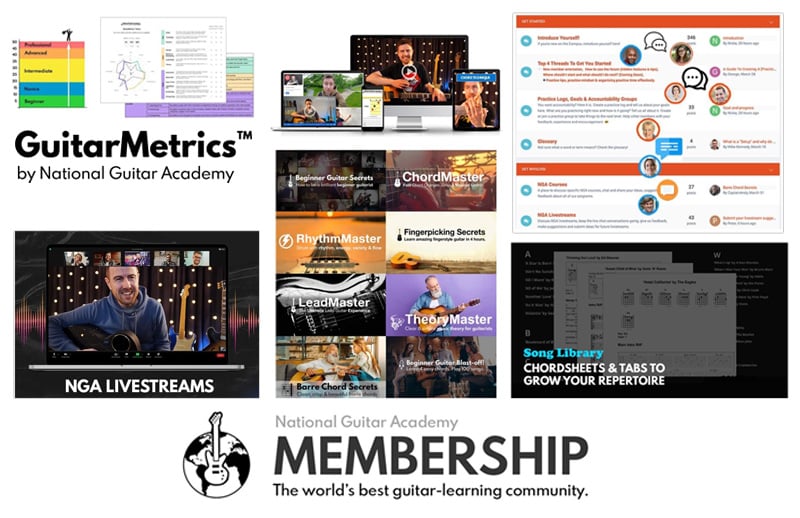
Cool Guitar T-shirts 😎
Look cooler! Check out our merch: Click here to see our merch store
Want free guitar tips and video lessons delivered to your inbox?
Join over 100,000 guitar-learners and subscribe to our guitar-tips-by-email service. (It's free.)
We'll send you a series of lessons that will move you to the next level of your guitar journey.
Learn how everything fits together quickly, easily and effectively. We share ninja tips (for instant fun!) but also timeless fundamentals that will deepen your understanding.


Get our best guitar tips & videos
Popular Lessons
How To Learn Guitar: An 11-Step Programme For Beginners
How To Choose The Perfect Beginner Guitar
More Cool Guitar Stuff
Learn about National Guitar Academy: About Us
Join us on Facebook for daily guitar tips.
Listen to our Learn Guitar Podcast for rapid guitar progress.
Check out our free chord lessons.



